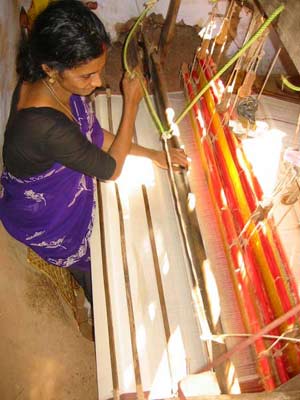 | « Back to article | Print this article |
 US President Barack Obama is swearing by swadeshi. But India, that once swore by khadi and based its freedom movement on the power of the loom, has not done much for its millions of weavers in 60 years.
US President Barack Obama is swearing by swadeshi. But India, that once swore by khadi and based its freedom movement on the power of the loom, has not done much for its millions of weavers in 60 years.
There are small efforts here and there, but nothing which targets each and every loom and seeks to empower every artisan.
What inspires hope, however, are two parallel efforts: One from the government and one from from the private sector.
The Ministry of Textile's Integrated Handloom Cluster Development Scheme, launched a couple of years ago, links handloom clusters to banks and markets by forming them into self-help groups and producer companies.
But its reach is limited to just 20 handloom clusters in 13 states and there are no expansion plans to cover the 6.5 million employed in handloom weaving in the country, earning between Rs 30 and Rs 100 a day.
These people operate in small units and spend more on raw materials than they earn from finished products. As for the latter, reports generated by the ministry point out how they suffer from want of diversification and innovation in design.
The other effort is Artisans Forum which is being created by the Jaipur Rugs Foundation (a top name in the carpet industry) and the Institute of Rural Management, Anand.
The purpose is to create an entrepreneur out of every artisan, giving him the dignity he deserves and not forcing him to migrate to cities for low-skill jobs.
The model involves taking weavers from households to a neighbouring production centre which doubles their earnings. About 300 production centres are then aggregated under a common facility centre, located within 25 km, according to Jaipur Rugs Founder and Managing Director N K Chaudhury.
The common facility centres, where all the dyeing and other supplementary work gets done, will be aggregated under Artisans Forum. The first common facility centre has already come up in Alwar.
Jaipur Rugs has been following this model among the 40,000 weavers who have been supplying products to it in the last three decades, and has seen their earnings go up. Jaipur Rugs Foundation recently signed a memorandum of understanding with Irma to take this model to carpet weavers across the country and, gradually, to other crafts as well.
Still, as Chaudhury says, the fact is weavers are fast shrinking in numbers and, if the industry is to survive, their lot has to improve.
He cites the example of carpet-weaving countries like China, Iran, Turkey and Afghanistan where the industry is dying. For instance, while Iran does not have new designs, Turkey does not have labour.
This is where the common facility centres come in. In fact, the first one under Artisans Forum on three bighas of land in Alwar's Narayangadh is owned by artisans who hold 80 per cent equity.
Production centres in about 60 villages located around it supply to the centre, says Jaipur Rugs Foundation CEO Vinod Kaushik.
Now the forum plans 10 common facility centres and 1,000 production centres in the next decade, starting with Gujarat and Maharashtra.
The cost of setting up a facility centre is Rs 9 crore (Rs 90 million), while that of setting up a production centre is about Rs 700,000.
That does not worry the foundation. Donations are making its work easier with the entire Alwar effort being funded by two donors.
And carpet making countries are keen to learn this model. Chaudhury is willing to share it all, so long as it keeps the looms alive -- both swadeshi and videshi.